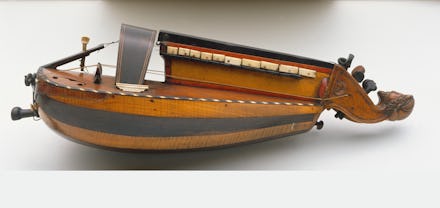7 Strange and Ancient Instruments You've Never Heard

Humans played the very first instruments thousands of years ago — 42,000 or 43,000 years ago, to be as exact as possible. The oldest known instruments are flutes carved from bird bone and mammoth ivory. But instruments, like musicians, go out of style (except maybe Taylor Swift). The usual suspects have been pretty constant — guitar, piano, drums, bass, horns — but there are a host of musical instruments that have been all but forgotten by mankind.
The nyckelharpa may have gone out of style, but some skillful, exploratory musicians still play them. One of those musicians is Clare Salaman, a multi-instrumentalist and the director of the Society of Strange and Ancient Instruments.
"Instruments go out of style because, in this day and age, we have a tendency to standardize everything," Salaman told Mic. "We have the standard orchestra, and children in school learn those standard orchestral instruments or piano. But in times gone past, 200, 300, 400 years ago, people didn't have this concept of standardization.
"Anything that doesn't fit into one of those categories we seem to have difficulty with these days."
It's not just instruments that are standardized today — so is the music they create. That's why ancient instruments are more important now than ever. By taking inspiration from the past, contemporary musicians who use the same old repertoire can break out of the mold and create something fresh. Here are some of the most fascinating ancient instruments that still exist today.
Nyckelharpa
The nyckelharpa, an over 600-year-old Swedish instrument, is Salaman's favorite. "It's a bowed, keyed fiddle — a great instrument that goes back to medieval times," she said. The first time she ever played it, "It was just a revelation. It was absolutely fantastic because the sound it makes is so glorious. And it felt natural to play it. It felt like I was coming home."
According to the American Nyckelharpa Association, "The instrument almost died out during the first part of the 1900s, but by riding the 'green wave' of the 1960s and '70s it has made quite a comeback." That "comeback," according to Salaman, means that about 100 musicians in the U.K. play it today.
Hurdy-gurdy
Not to be confused with "Hurdy Gurdy Man" by Donovan, this highly intricate instrument sounds its strings when the musician turns a crank.
"The hurdy-gurdy is the only musical instrument that uses a crank to turn a wheel to rub strings like the bow of a violin to produce music," musician Caroline Phillips says in her TED Talk on the instrument. "All of this is pretty innovative, if you consider that the hurdy-gurdy appeared about a thousand years ago." Though it's certainly an old instrument, its sound is probably most comparable to an analog synthesizer.
Santur
The first santur, a beautiful and complex instrument, showed up around 1000 A.D. Shown in the video above, the Iranian version of the santur usually has 72 strings the musician plays with tiny hammers. "The Iranian version is very much a classical instrument," the Society of Strange and Ancient Instruments writes on its website, "and is unique in the family in that it is played with featherweight hammers that demand an exacting wrist technique."
In 2008, the instrument got its moment in the sun when it was featured on "Life in Technicolor," the opening track off Coldplay's Viva la Vida.
Mbira
The mbira, aka the thumb piano, is a traditional Zimbabwe instrument that's still played in Africa today. The instrument is usually homemade, and it's constructed by mounting metal keys onto a hardwood soundboard. The mbira is used at religious and social occasions to this day, and a small economy still exists in Africa that makes the instruments to sell.
According to Mbira.org, "The buzz is considered an essential part of the mbira sound, required to clear the mind of thoughts and worries so that the mbira music can fill the consciousness of the performers and listeners."
Qanun
The qanun, an ancient Middle Eastern instrument, has been played by musicians since 950 A.D. It's made with a base of wood overlaid with between 74 and 81 strings, and musicians play it on their laps by plucking the strings with picks or fingernails. The name comes from the Greek for "canon," meaning "rule," likely because its tuning sets the rule for other instruments and singers in an ensemble led by the qanun.
Saung
The strikingly beautiful saung is the national instrument of Myanmar, where Buddhist musicians have played the curved harp since 200 A.D. The base is made from the wood of a tree that naturally curves to form the shape of the harp, and its 16 finger-plucked strings are made of silk.
According to the National Music Museum, "During the construction of a Burmese arched harp, a ceremony may be conducted to invite nat spirits to dwell within the harp, to 'enliven its tunes.' These spirits are believed to leave the harp through the soundholes while it is being played and return afterward."
Voice
You've heard of this one. Still, the human voice is the oldest instrument of all time — older even than those mammoth ivory flutes. "The way we've used our voices has changed a lot in the last 100 years," Salaman said.
"Now, our classical singers are trained to produce a sound which can fill concert halls. Before that, music would have been performed in a small room or a church, so people didn't have to produce these enormous penetrating sounds in the same way. We know from early recordings of voices from the 19th century they just sound so different; they don't sing even with vibrato."
Music is timeless, but our instruments are always changing. They shouldn't be forgotten.